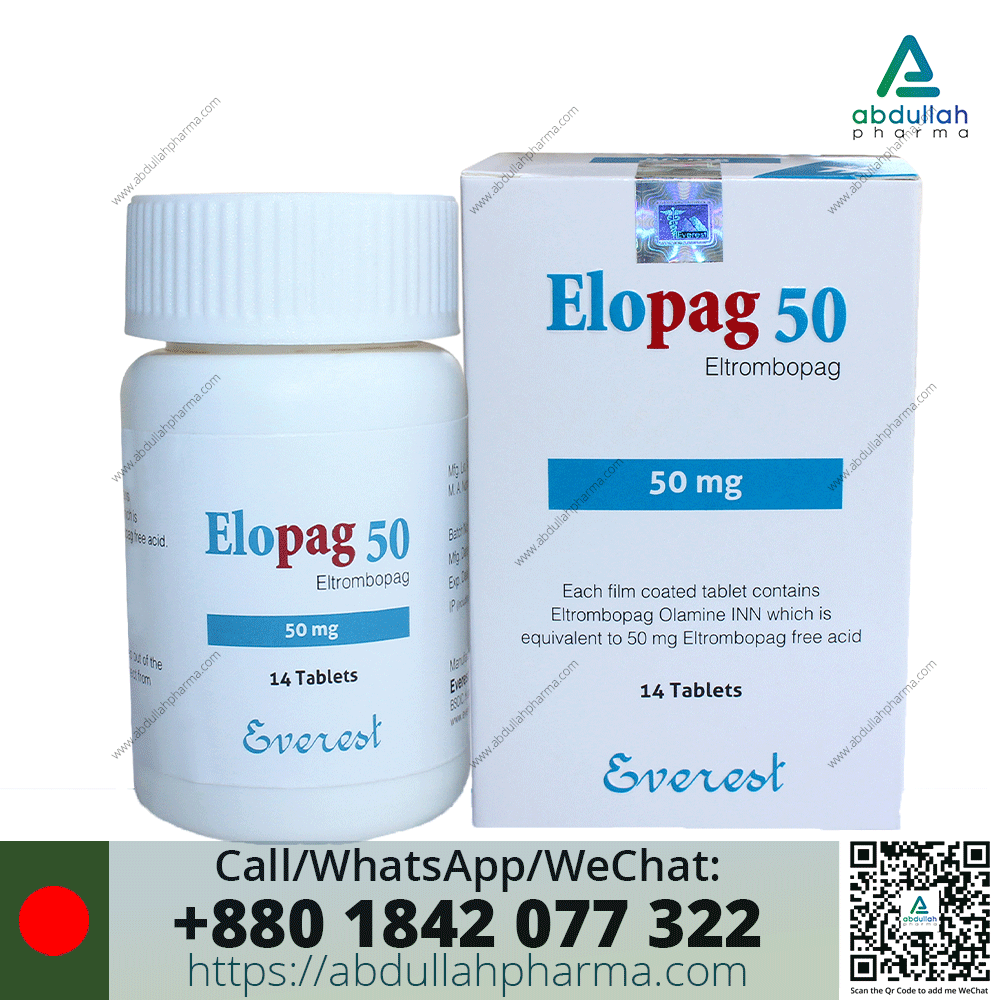Elopag Tablet
Indications
Therapeutic Class
Pharmacology
Dosage & Administration
- Adult and Pediatric Patients 6 Years and Older with ITP: Initiate Eltrombopag at a dose of 50 mg once daily, except in patients who are of East Asian ancestry (such as Chinese, Japanese, Taiwanese or Korean) or who have mild to severe hepatic impairment (Child-Pugh Class A,B,C). For patients of East Asian ancestry with ITP, initiate Eltrombopag at a reduced dose of 25 mg once daily. For patients with ITP and mild, moderate or severe hepatic impairment (Child-Pugh Class A,B,C), initiate Eltrombopag at a reduced dose of 25 mg once daily.
- For patients of East Asian ancestry with ITP and hepatic impairment (Child-Pugh Class A,B,C), consider initiating Eltrombopag at a reduced dose of 12.5 mg once daily. Pediatric Patients with ITP Aged 1 to 5 Years: Initiate Eltrombopag at a dose of 25 mg once daily.
Chronic Hepatitis C-associated Thrombocytopenia-
- Initiate Eltrombopag at a dose of 25 mg once daily. Monitoring and Dose Adjustment: Adjust the dose of Eltrombopag in 25-mg increments every 2 weeks as necessary to achieve the target platelet count required to initiate antiviral therapy. Monitor platelet counts every week prior to starting antiviral therapy. During antiviral therapy, adjust the dose of Eltrombopag to avoid dose reductions of Peginterferon. Monitor CBCs with differentials, including platelet counts, weekly during antiviral therapy until a stable platelet count is achieved. Monitor platelet counts monthly thereafter. Do not exceed a dose of 100 mg daily. Monitor clinical hematology and liver tests regularly throughout therapy with Eltrombopag.
Severe Aplastic Anemia-
- Initiate Eltrombopag at a dose of 50 mg once daily. For patients with severe aplastic anemia of East Asian ancestry or those with mild, moderate or severe hepatic impairment (Child-Pugh Class A,B,C), initiate Eltrombopag at a reduced dose of 25 mg once daily.
Interaction
Contraindications
Side Effects
In patients with chronic hepatitis C-associated thrombocytopenia, the most common adverse reactions (greater than or equal to 10% and greater than placebo) were: anemia, pyrexia, fatigue, headache, nausea, diarrhea, decreased appetite, influenza-like illness, asthenia, insomnia, cough, pruritus, chills, myalgia, alopecia and peripheral edema. In patients with severe aplastic anemia, the most common adverse reactions (greater than or equal to 20%) were: nausea, fatigue, cough, diarrhea and headache.
Pregnancy & Lactation
Nursing Mothers: It is not known whether Eltrombopag is excreted in human milk. Because many drugs are excreted in human milk and because of the potential for serious adverse reactions in nursing infants from Eltrombopag, a decision should be made whether to discontinue nursing or to discontinue Eltrombopag taking into account the importance of Eltrombopag to the mother.
Precautions & Warnings
Thrombotic or Thromboembolic Complications: Portal vein thrombosis has been reported in patients with chronic liver disease receiving Eltrombopag. Monitor platelet counts regularly.
Use in Special Populations
Geriatric Use: Of the 106 patients in two randomized clinical trials of Eltrombopag 50 mg in chronic ITP, 22% were 65 years of age and over, while 9% were 75 years of age and over. In the two randomized clinical trials of Eltrombopag in patients with chronic hepatitis C and thrombocytopenia, 7% were 65 years of age and over, while fewer than 1% were 75 years of age and over. No overall differences in safety or effectiveness were observed between these patients and younger patients in the placebo-controlled trials, but greater sensitivity of some older individuals cannot be ruled out.
Hepatic Impairment: Hepatic impairment influences the exposure of Eltrombopag. Reduce the initial dose of Eltrombopag in patients with chronic ITP (adult and pediatric patients 6 years and older only) or severe aplastic anemia who also have hepatic impairment (Child-Pugh Class A, B, C). No dosage adjustment is necessary for patients with chronic hepatitis C and hepatic impairment.
Renal Impairment: No adjustment in the initial dose of Eltrombopag is needed for patients with renal impairment. Closely monitor patients with impaired renal function when administering Eltrombopag.
Overdose Effects
In one report, a subject who ingested 5,000 mg of Eltrombopag had a platelet count increase to a maximum of 929 x 109/L at 13 days following the ingestion. The patient also experienced rash, bradycardia, ALT/AST elevations and fatigue. The patient was treated with gastric lavage, oral Lactulose, Intravenous fluids, Omeprazole, Atropine, Furosemide, Calcium, Dexamethasone, andPlasmapheresis; however, the abnormal platelet count and liver test abnormalities persisted for 3 weeks. After 2 months follow-up, all events had resolved without sequelae.
In case of an overdose, consider oral administration of a metal cation-containing preparation, such as Calcium, Aluminum, or Magnesium preparations to chelate Eltrombopag and thus limit absorption. Closely monitor platelet counts. Reinitiate treatment with Eltrombopag in accordance with dosing and administration recommendations.
Storage Conditions
/*54745756836*/












Reviews
There are no reviews yet.